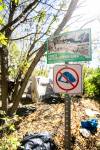Moving at the speed of trust Collaboration, compassion and a clear sense of purpose among non-profit agencies and government recently moved more than 30 people out of homeless encampments and into supportive housing
Read this article for free:
or
Already have an account? Log in here »
To continue reading, please subscribe:
Monthly Digital Subscription
$0 for the first 4 weeks*
- Enjoy unlimited reading on winnipegfreepress.com
- Read the E-Edition, our digital replica newspaper
- Access News Break, our award-winning app
- Play interactive puzzles
*No charge for 4 weeks then price increases to the regular rate of $19.00 plus GST every four weeks. Offer available to new and qualified returning subscribers only. Cancel any time.
Monthly Digital Subscription
$4.75/week*
- Enjoy unlimited reading on winnipegfreepress.com
- Read the E-Edition, our digital replica newspaper
- Access News Break, our award-winning app
- Play interactive puzzles
*Billed as $19 plus GST every four weeks. Cancel any time.
To continue reading, please subscribe:
Add Free Press access to your Brandon Sun subscription for only an additional
$1 for the first 4 weeks*
*Your next subscription payment will increase by $1.00 and you will be charged $16.99 plus GST for four weeks. After four weeks, your payment will increase to $23.99 plus GST every four weeks.
Read unlimited articles for free today:
or
Already have an account? Log in here »
When two Winnipeg encampments that had more than 30 people living in them were about to be cleared earlier this summer, outreach groups, government officials and housing facilitators sprang into action.
In a co-ordinated push, they worked quickly to find permanent homes — the kind of behind-the-scenes collaboration that seldom makes headlines.
This week, around a cluster of tables inside Main Street Project, leaders from three front-line outreach organizations — MSP, West Central Women’s Resource Centre and Resource Assistance for Youth — gathered in person and online. Joining them were a representative from the city and the administrator who oversees the provincial government’s encampment strategy.
They discussed the recent crisis that had demanded swift, citywide collaboration.
Details remain guarded to protect those involved, but what unfolded in that meeting pulled back the curtain on a level of co-ordination the public rarely sees.
It was collaboration that, in some cases, meant the difference between survival and tragedy.
MIKE DEAL / FREE PRESS Clockwise from left Jarred Baker, senior advisor on homelessness for City of Winnipeg, Lorie English, executive director, West Central Women’s Resource Centre, Cindy with Main Street Project, via video link, Kate Sjoberg, Executive Director, Resource Assistance for Youth Inc., Jamil Mahmood, executive director of Main Street Project, and Karen Murisonwith Main Street Project during a meeting with homelessness groups involved in the Your Way Home Strategy in the boardroom at Main Street Project Tuesday afternoon. 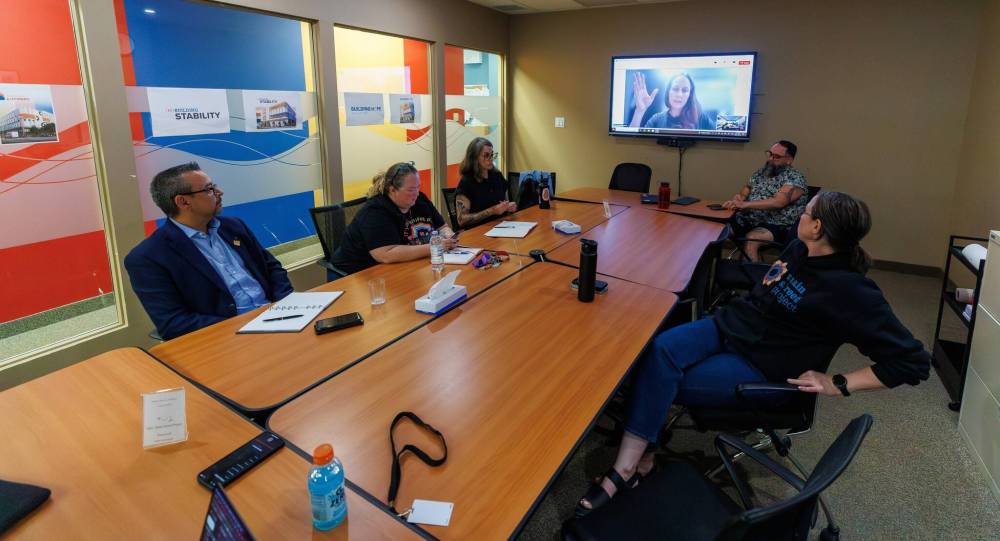
The people in the two encampments needed to be housed quickly. The issue shot to the top of the agenda, propelled by mounting public concern, political pressure and, above all, fear for the well-being of the people living in them.
For the plan to succeed, permanent housing units had to open up fast — not just roofs and walls, but homes with wraparound supports to meet needs ranging from untreated trauma to active addiction. Partners were pulled in, including Manitoba Housing.
Next came outreach groups. At N’Dinawemak, which operates a 220-bed shelter on Disraeli Freeway, staff leaned on trust built with encampment residents to explore what housing arrangements would work best. Staffing was also critical. Several workers were rehired to help, and N’Dinawemak co-ordinated short-term supports. The organization wasn’t expected to run the operation long-term, but its ability to step in quickly was vital.
WCWRC was asked to take on one encampment directly.
Its team maintained a daily presence, building relationships and walking residents through their options. When the move finally came, WCWRC led the relocation, helping people pack up and transition into housing, then passed critical details to N’Dinawemak, which took the lead on support services, including cultural resources.
“We wanted to ensure there was a continuum of care,” said WCWRC executive director Lorie English.
“We wanted to ensure there was a continuum of care.”
Meanwhile, other partners worked to set people up for success. The unit turnover committee — made up of groups including Oyate Tipi Cumini Yape, Sunshine House and Siloam Mission — ensured the identified housing was move-in ready.
“Some had beds, but not bedding,” said Tessa Blaikie Whitecloud, the province’s co-ordinator of the Your Way Home strategy, which aims to end chronic homelessness by 2031.
“They aren’t directly housing any of these folks, but they knew they were being housed by other agencies, and pulled together what’s called a move-in kit… pots, pans, cutlery, cleaning supplies, sheets — everything you need when you first move into housing that you wouldn’t have, otherwise.”
A daily update system helped to keep the effort on track.
MIKAELA MACKENZIE / FREE PRESS FILES Two encampments were cleared earlier this summer. 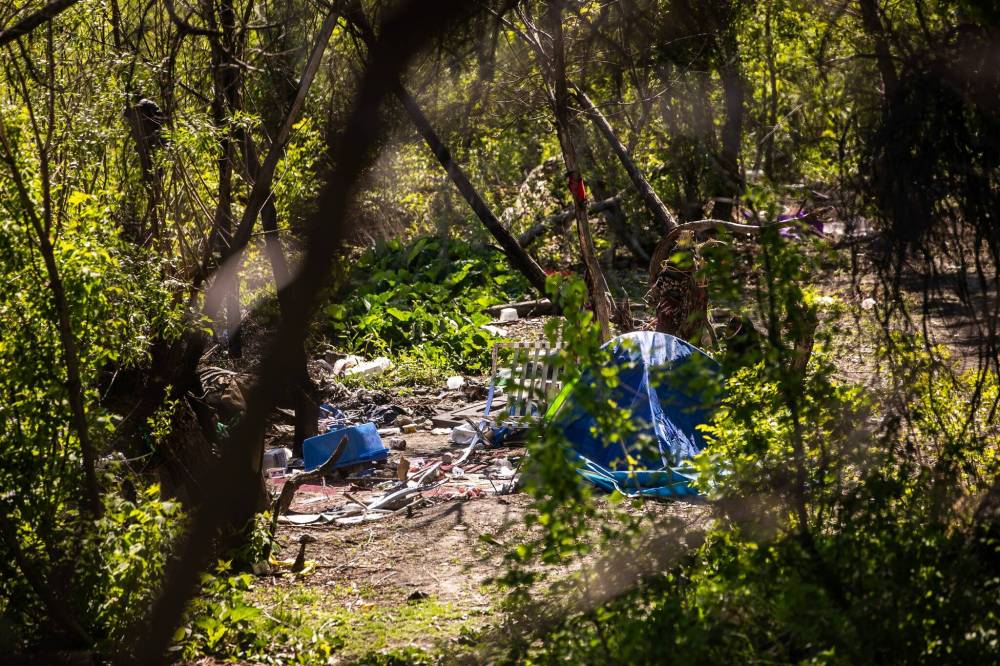
“We all knew what was happening… and we worked together to do those things,” said Jarred Baker, the city’s senior adviser on homelessness and a board member of End Homelessness Winnipeg.
The city’s role kicked in after, including site cleanup and beautification of the former encampment sites.
“It’s a massive amount of collaboration,” said Karen Murison, MSP’s interim director of community initiatives.
Building meaningful relationships with people is vital, especially among those who have been repeatedly disappointed and who have experienced systemic harm and oppression.
Of the more than 30 people housed during the frantic effort, only one has left.
That underscores an important truth — that getting homeless people into housing isn’t where the job ends. The high retention rate is critical. Failed housing attempts often entrench people further in homelessness.
“People who’ve been housed unsuccessfully before are less willing to have conversations about housing,” Blaikie Whitecloud said. “They’re less interested in housing. They’re less likely to see themselves as succeeding in housing.
There is little hard data on the effect of those failed attempts, but Blaikie Whitecloud said 20 per cent of the people MSP approached about housing indicated they were apprehensive about accepting new placements because of what had happened previously.
MIKE DEAL / FREE PRESS FILES Tessa Blaikie Whitecloud said 20 per cent of the people approached about housing indicated they were apprehensive about accepting new placements because of what had happened previously.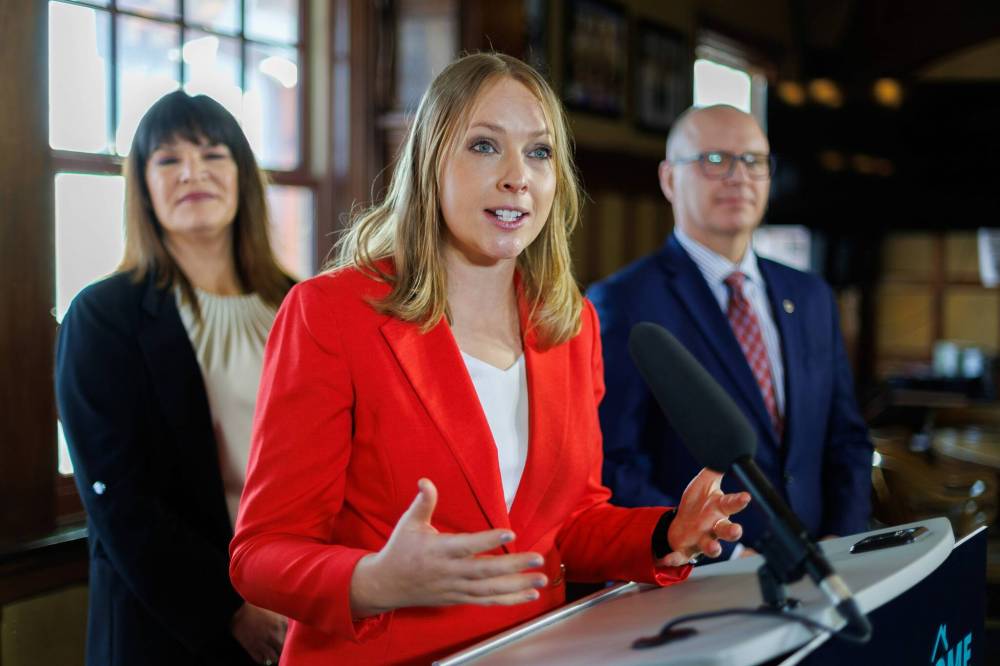
In such cases, a gentler approach can help.
“We’re showing up and saying, ‘What do you need? Where are you at the things? Let’s walk through this work together, let’s walk through the available housing,’” said MSP executive director Jamil Mahmood.
Before WCWRC presented the arranged housing to the people it had been assigned to help, English’s team spent a week making daily trips to the encampment.
“Just to talk… to build relationships,” she said
She pointed to another collaborative effort — one she believes saved a vital relationship with a woman who didn’t trust sector services.
“Without the collaboration between our agencies and our ability to share information and wrap supports around this extremely vulnerable community member, she would have been lost,” English said.
A few years ago, that woman spent her nights in the alcove outside WCWRC’s Ellice Avenue office. Later, she pitched a tent in the garden. She regularly accessed food and showers at the drop-in, used MSP’s shelter and services at Mount Carmel Clinic.
“We were working with her slowly,” English said. “She lived with complex mental health. Trust was a really big thing.”
“We were working with her slowly. She lived with complex mental health. Trust was a really big thing.”
One day, emergency services were called, and Winnipeg Fire Paramedic Service responded. A firefighter entered her tent, which made matters worse.
She said outreach workers immediately intervened, reassuring both the woman and WFPS. She even stood between the firefighter and the woman to protect her.
Eventually, data collected by the women’s resource centre and MSP helped identify appropriate supports. WCWRC worked with her during the day, and MSP sheltered her at night.
“I know that relationship was the only way to connect her to supports, to keep her in that realm of help,” English said.
RAY executive director Kate Sjoberg explained people who have never been homeless don’t understand the skills needed to survive unsafe situations.
“Collective care is one of the strategies many people use to stay safe when they are unhoused,” she said. “One of the ways people stay safe when they’re unsheltered is they move, and they move away from places that feel unsafe and toward those which feel safe.”
Blaikie Whitecloud said the province’s encampment strategy tries to address such situations by bringing police and emergency services to the table to promote accountability and communication.
“How do we make sure that we’re being trauma-informed across all of the partners at the table?” she said. “That’s working with the city on that. That’s working with police on that. That’s working with fire services.”
English said people experiencing homelessness are often robbed of choice: where to sleep, where to eat and whether a space is safe. Sometimes, the only choice they have is to decline an offer of a place to live.
MIKE DEAL / FREE PRESS FILES “When we wrap people with supports, when we know what their needs are prior to placing them in housing, we have better success at placing them in housing,” Lorie English says.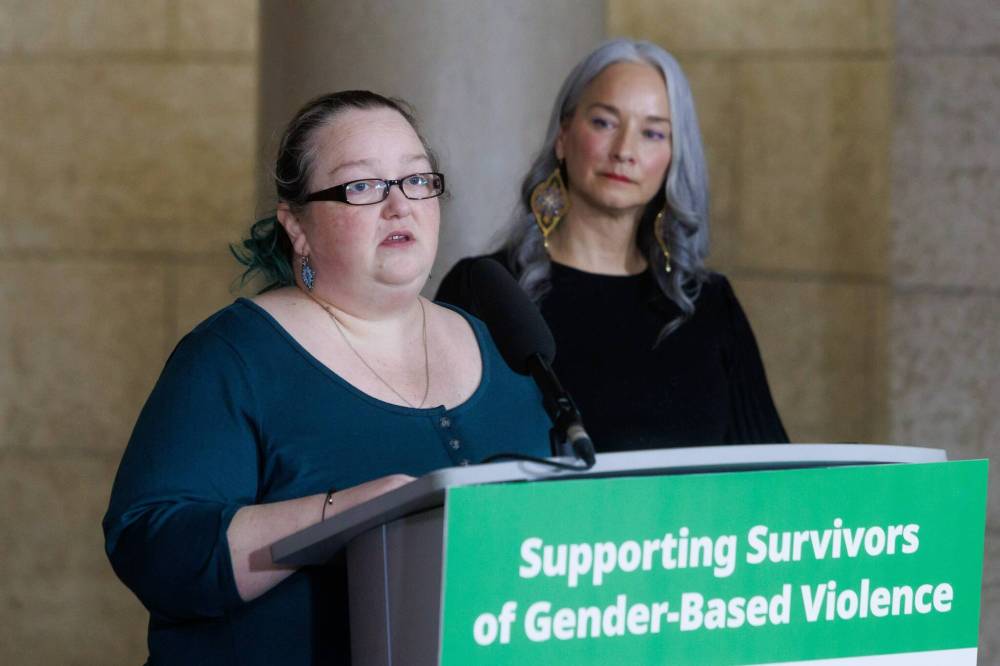
For outreach teams, offering even small choices goes a long way toward establishing trust.
“It allows residents to believe that they’re not just being pulled out of an encampment and that’s it, but rather a sense that they actually care where they’re going to be and how they’re going to be sustained long-term,” Mahmood said.
Many who seek housing carry painful memories of eviction.
“They need to be assured that those things aren’t going to happen again,” English said.
That begins with listening closely to what went wrong in the past and working to avoid a repeat.
“When we look at a housing-first approach, when we look at a human rights-based approach to housing, we see the kinds of success we’re seeing through this strategy,” English said.
“When we wrap people with supports, when we know what their needs are prior to placing them in housing, we have better success at placing them in housing that’s going to be appropriate to them, and we have options to move them if we don’t get it right on the first try.”
“I don’t care if your number is 250 if none of them stay housed. That’s the question we need to ask: how many of them are staying housed?”
Premier Wab Kinew launched the Your Way Home plan to tackle chronic homelessness in January. The first two years of the strategy focuses on the estimated 700 people who were living in encampments when the announcement was made.
The initiative has moved about 10 per cent of that number in the past nine months. English said the critics who’ve made an issue out of the fact that only 77 people have been housed thus far are missing the point.
The shared view in the meeting at MSP is that, while the pace may seem sluggish, the approach is working — focusing on how many people remain in stable housing, rather than how many are moved, and how quickly.
“I don’t care if your number is 250 if none of them stay housed,” English said. “That’s the question we need to ask: how many of them are staying housed?”
Moving people into housing too quickly can be dangerous.
Sjoberg recalled a couple she supported at an encampment next to the Assiniboine River last year, where a lack of collaboration posed a serious safety risk to a pregnant woman.
“When we rush, when we remove choice, we don’t hear the information that can help us ensure safety, ensure more success in housing.”
Due to a miscommunication, another organization placed the couple into housing without knowing about the delicate situation.
“What we were navigating very carefully was the fact of intimate partner violence between the couple,” she said, not naming the other agency involved.
She proceeded cautiously to preserve the fragile sense of safety, knowing the two would continue interacting — and that any conflict could endanger them, especially the pregnant woman.
“When we move at the speed of trust, we learn so much more information about what’s actually happening as opposed to what the person wants to tell you that’s palatable in a situation where they are interacting with a stranger who has more power than them,” Sjoberg said. “When we rush, when we remove choice, we don’t hear the information that can help us ensure safety, ensure more success in housing.”
Mahmood is clear: if provincial and municipal leaders are serious about addressing the homeless issue, Winnipeg needs several fully funded outreach teams.
“I think what (the effort to move two encampments) showed was we couldn’t just do it with our outreach team,” he said. “It needed the support of multiple other partners in the sector. Right now, not everyone is funded to do that continuously.”
MIKE DEAL / FREE PRESS Jamil Mahmood says Winnipeg needs several fully funded outreach teams.

MSP has the city’s only outreach contract, but it doesn’t cover the full cost of operating a 24-7 mobile team — the only one of its kind in Winnipeg, often staffed by just two people per shift.
Mahmood said outreach should be considered a core social service, on par with policing, emergency response and health care.
“This is an essential part of community right now,” he said, adding that without available housing, more resources must be added to improve the work being done on the streets.
English cautioned that when funding disappears, so does the possibility of collective caring.
WCWRC has been in contact with the province about possible funding as it hopes to offer outreach services again.
“If we want any housing strategy, whether it’s Your Way Home or anything, to be successful, what does that funding model look like, and are we prepared to pay for it?” she said, adding there’s no quick fix.
“It takes as long to walk out of the forest as it does to walk into it.”
scott.billeck@freepress.mb.ca

Scott Billeck is a general assignment reporter for the Free Press. A Creative Communications graduate from Red River College, Scott has more than a decade’s worth of experience covering hockey, football and global pandemics. He joined the Free Press in 2024. Read more about Scott.
Every piece of reporting Scott produces is reviewed by an editing team before it is posted online or published in print — part of the Free Press‘s tradition, since 1872, of producing reliable independent journalism. Read more about Free Press’s history and mandate, and learn how our newsroom operates.
Our newsroom depends on a growing audience of readers to power our journalism. If you are not a paid reader, please consider becoming a subscriber.
Our newsroom depends on its audience of readers to power our journalism. Thank you for your support.





